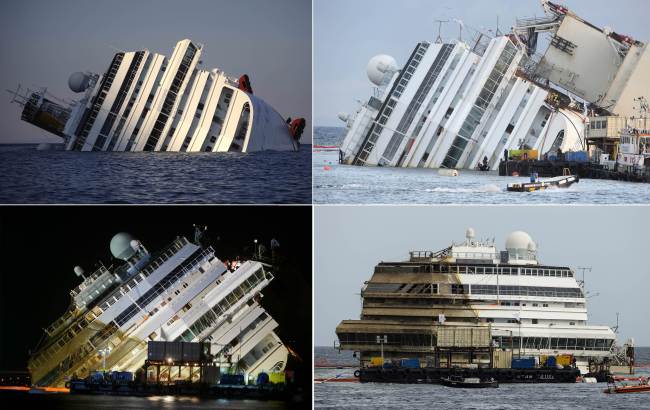The causes may be very different and the toll far heavier but Italian media have pointed to similarities between the ferry disaster of the Sewol in South Korea and the Costa Concordia cruise ship crash in 2012.
“A case of Schettino in Korea” has been the recurring headline in Italian newspapers in the past few days ― a reference to the Italian liner’s captain now on trial for an accident in which 32 people lost their lives.
With South Korean rescuers reporting 270 people missing and 32 confirmed dead, Italian media have focused on the role played by the ferry’s captain Lee Joon-Seok, who was arrested on Saturday along with two of his crew.
 |
This photo compilation made on Sept. 17, 2013 shows four photos of the Costa Concordia, after the cruise ship ran aground and keeled over off the Isola del Giglio taken on Jan. 14, 2012 (top left), beginning to emerge during the salvage operation on Sept. 16, 2013 (top right) and (bottom left) and after it was turned upright (bottom right) on Sept. 17, 2013. (AFP-Yonhap) |
Here are five similarities between the disasters:
1. Captain in charge
Schettino was partying with friends until minutes before the crash but was back on the bridge when it happened, although witnesses at his trial have said he appeared distracted and reported confusion about whether he was in control.
The Italian captain’s defense has claimed that the Indonesian helmsman twice misunderstood steering orders, although experts say the ship was travelling at such a speed that the crash may have been unavoidable.
In the South Korean case, Lee has confirmed that he was not the helm when the Sewol ran into trouble, and was returning to the bridge from his cabin.
Prosecutors have said that the third officer was in command when the accident took place.
2. Delayed evacuation
When the Costa Concordia crashed into rocks off the Tuscan island of Giglio and began listing badly near the coastline, panicked passengers were initially told to put on their life jackets and wait inside their cabins.
The order to abandon ship finally came more than an hour after the initial crash and when the ship was almost entirely keeled over, hugely complicating the evacuation because it was difficult or impossible to lower the lifeboats.
In the case of the South Korean ferry disaster, Captain Lee was asked by reporters at a police station during his arrest why the passengers had been ordered not to move for more than 40 minutes after the ship first foundered.
He said that it was a safety measure because there were no other ships in the area that could come to the rescue, adding: “I thought that passengers would be swept far away and fall into trouble if they evacuated thoughtlessly”.
3. Captain leaves?
One of the charges against Schettino in his ongoing trial is that he abandoned the ship early. He has defended himself saying that he fell onto a lifeboat and was then better able to coordinate the evacuation from the shore.
Captain Lee and his 28 crew, most of whom survived the disaster, have been heavily criticized after reports they were among the first to abandon ship.
4. Capsized ship
The sight of the Sewol keeled over off the peninsula’s southwest coast before it sank have brought back memories of the Costa Concordia.
Survivors from both disasters reported the same types of difficulties moving in a ship at a 90-degree tilt, with objects falling over, walls becoming floors and corridors quickly turning into perilous flooded wells.
Some of the people rescued in South Korea were seen sliding down the steeply inclined side into the water.
Three years ago in Italy dozens of passengers jumped into the sea or clambered across the exposed hull.
5. Difficult rescue
Divers in Italy and South Korea both had to break into the respective ships to access them and reported problems with low visibility in the water.
South Korean divers have finally entered the ship more than 48 hours after it went down, with one of them saying after turning to the harbor: “You can hardly see your hand in front of you face.”
In the Costa Concordia disaster, divers entering the ship used ropes to find their way back out of the vessel with one describing it at the time as a “labyrinth” with visibility as low as just 10 centimeters. (AFP)





![[Herald Interview] 'Trump will use tariffs as first line of defense for American manufacturing'](http://res.heraldm.com/phpwas/restmb_idxmake.php?idx=644&simg=/content/image/2024/11/26/20241126050017_0.jpg)

![[Herald Review] 'Gangnam B-Side' combines social realism with masterful suspense, performance](http://res.heraldm.com/phpwas/restmb_idxmake.php?idx=644&simg=/content/image/2024/11/25/20241125050072_0.jpg)
![[Health and care] Getting cancer young: Why cancer isn’t just an older person’s battle](http://res.heraldm.com/phpwas/restmb_idxmake.php?idx=644&simg=/content/image/2024/11/26/20241126050043_0.jpg)